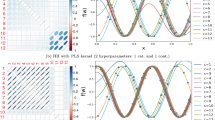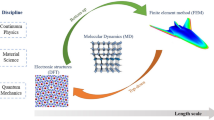Abstract
In an increasingly competitive and digital industrial environment, the optimization of structures is a key point not only to reduce costs but also to reduce the consumption of natural resources. To this end, different approaches have emerged throughout history based on the tools available at the time. With the current rise of artificial intelligence and the concept of machine learning, revolutionary ideas are emerging that allow an optimal dimensioning of structures in record time. This work presents the use of variational autoencoders and mixed-variable solvers as a proposal for structural optimization and material selection. It has expanded upon previous research by advancing in three directions: (1) incorporating more material attributes, particularly relevant for environmental considerations; (2) analyzing in more detail aspects of VAEs such as the dimensionality of the latent space; and (3) a two-step hybrid approach to select the optimal candidate: preliminary filtering with VAE and final design via mixed-variable model. Various examples demonstrate the applicability of the proposed method.
























Similar content being viewed by others
References
Ashby MF (2011) Material selection in mechanical design. Butterworth-Heinemann, Oxford
Barjhoux P-J, Diouane Y, Grihon S, Bettebghor D, Morlier J (2020) A bi-level methodology for solving large-scale mixed categorical structural optimization. Struct Multidisc Optim 62(1):337–351
Barjhoux P-J, Diouane Y, Grihon S, Morlier J (2022) An outer approximation bi-level framework for mixed categorical structural optimization problems. Struct Multidisc Optim 65(8):214
Blank J, Deb K (2020) Pymoo: multi-objective optimization in python. IEEE Access 8:89497–89509
Burda Y, Grosse R, Salakhutdinov R (2015) Importance weighted autoencoders. arXiv Preprint. arXiv:1509.00519
Chandrasekhar A, Sridhara S, Suresh K (2022) Integrating material selection with design optimization via neural networks. Eng Comput 38(5):4715–4730
Ching E, Carstensen JV (2022) Truss topology optimization of timber–steel structures for reduced embodied carbon design. Eng Struct 252:113540
Diederik PK, Ba JL (2015) Adam: a method for stochastic optimization. In: ICLR 2015—conference track proceedings. International conference on learning representations
Diederik PK, Welling M (2013) Auto-encoding variational bayes. arXiv Preprint. http://arxiv.org/abs/1312.6114
Duriez E, Morlier J, Azzaro-Pantel C, Charlotte M (2022) Ecodesign with topology optimization. Procedia CIRP 109:454–459
Duriez E, Azzaro-Pantel C, Morlier J, Charlotte M (2023a) A fast method of material, design and process eco-selection via topology optimization, for additive manufactured structures. Clean Environ Syst 9:100114
Duriez E, Martín VMG, Joseph M (2023b) CO2 footprint minimization of solar-powered hale using MDO and eco-material selection. Sci Rep 13(1):11994
Eggert R (2005) Engineering design. Pearson/Prentice Hall, Upper Saddle River
GitHub code: structural material selection using deep learning. https://github.com/mid2SUPAERO/HybML-EvoMatDesEco. Accessed 16 Aug 2023
Goodfellow I, Bengio Y, Courville A (2016) Deep learning. MIT Press, Cambridge
Jahan A, Ismail MY, Sapuan SM, Mustapha F (2010) Material screening and choosing methods—a review. Mater Des 31(2):696–705
Kingma DP, Welling M. Auto-encoding variational bayes. arXiv preprint arXiv:1312.6114
Kingma DP, Welling M et al (2019) An introduction to variational autoencoders. Found Trends® Mach Learn 12(4):307–392
Manson JA, Chamberlain TW, Bourne RA (2021) MVMOO: mixed variable multi-objective optimisation. J Glob Optim 80(4):865–886
NSGA-II: non-dominated sorting genetic algorithm. https://pymoo.org/algorithms/moo/nsga2.html. Accessed 29 July 2023
Paszke A, Gross S, Massa F, Lerer A, Bradbury J, Chanan G, Killeen T, Lin Z, Gimelshein N, Antiga L, Desmaison A (2019) PyTorch: an imperative style, high-performance deep learning library. In: Advances in neural information processing systems, 32
Rakshit S, Ananthasuresh GK (2008) Simultaneous material selection and geometry design of statically determinate trusses using continuous optimization. Struct Multidisc Optim 35:55–68
Tawarmalani M, Sahinidis NV (2005) A polyhedral branch-and-cut approach to global optimization. Math Progr 103(2):225–249
Venkata Rao R (2006) A material selection model using graph theory and matrix approach. Mater Sci Eng A 431(1–2):248–255
Zhou C-C, Yin G-F, Xiao-Bing H (2009) Multi-objective optimization of material selection for sustainable products: artificial neural networks and genetic algorithm approach. Mater Des 30(4):1209–1215
Acknowledgements
The authors would like to acknowledge the assistance from Associate Professor Israel G. García, Departamento de Mecánica de Medios Continuos y Teoría de Estructuras, E.T.S. Ingeniería, Universidad de Sevilla, Camino de los Descubrimientos s/n,41092, Seville, Spain
Author information
Authors and Affiliations
Contributions
J.M. devised the original research project and proposed the global methodology. L.Y.L. designed the computational framework and analyzed the data. L.Y.L. wrote the draft manuscript with the inputs from all authors. K.S and S.S. revised the draft manuscript and proposed additional experiments: three dimensions and latent space of environmental attributes. All authors reviewed the results and approved the final version of the manuscript.
Corresponding author
Ethics declarations
Conflict of interest
On behalf of all authors, the corresponding author states that there is no conflict of interest.
Replication of results
Additional information
Responsible Editor: Zequn Wang
Publisher's Note
Springer Nature remains neutral with regard to jurisdictional claims in published maps and institutional affiliations.
Appendices
Appendix A: Annexed figures
Appendix B: annexed tables
Rights and permissions
Springer Nature or its licensor (e.g. a society or other partner) holds exclusive rights to this article under a publishing agreement with the author(s) or other rightsholder(s); author self-archiving of the accepted manuscript version of this article is solely governed by the terms of such publishing agreement and applicable law.
About this article
Cite this article
Yepes Llorente, L., Morlier, J., Sridhara, S. et al. A hybrid machine learning and evolutionary approach to material selection and design optimization for eco-friendly structures. Struct Multidisc Optim 67, 69 (2024). https://doi.org/10.1007/s00158-024-03777-z
Received:
Revised:
Accepted:
Published:
DOI: https://doi.org/10.1007/s00158-024-03777-z






